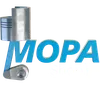INSPECTION PORT COVER Displays for Diesel and Gas Engines
Display components are the visual interface of an engine’s control and monitoring system. In marine propulsion, power generation, and industrial drive applications, a Display consolidates sensor data, controller feedback, and alarm logic into a clear, actionable view. That makes this article category indispensable: without a reliable Display, operators lose situational awareness, routine checks become slower and riskier, and maintenance decisions are harder to validate. Whether installed in an engine room console or on a bridge panel, modern Displays help protect assets, people, and uptime by delivering real-time visibility of critical engine functions.
Technical function of Display components with INSPECTION PORT COVER monitoring
A Display serves as the human–machine interface to engine automation. It acquires parameters over protocols such as CAN bus, Modbus, or Ethernet/IP from the engine control unit, alarm panel, and safety systems. On-screen views typically include cylinder temperatures, lube oil pressure, fuel rack position, turbocharger data, emissions trends, and auxiliary system status. Crucially, it also presents alarm states tied to safety-critical hardware—such as the INSPECTION PORT COVER marine engine status, crankcase pressure, and oil mist detector signals—so that operators can verify that inspection doors are closed and interlocks are cleared before start or after maintenance.
In a diesel engine, the Display provides event logging and time-stamped alarms when sensors detect open or improperly seated covers on the crankcase inspection doors. Toggle inputs or proximity switches on the inspection doors feed the automation, which in turn drives the on-screen alarm and, if configured, inhibits starting. This linkage helps prevent hazardous conditions associated with crankcase explosions. In addition, maintenance planners use trend views on the Display to correlate abnormal bearing temperatures or oil mist concentrations with inspection rounds, enabling proactive checks of the inspection covers and gaskets. Many systems also use configurable pages so the same Display can show INSPECTION PORT COVER diesel engine alarms alongside vibration spectra, slow-turn data, or purge status for a complete safety picture.
Where compliance and traceability are required, Displays support export of event logs and screenshots for audits. This is relevant when documenting that interlocks tied to INSPECTION PORT COVER OEM parts functioned correctly during start-up tests, harbor maneuvers, or post-drydock trials. Ruggedized variants with high brightness and glove-operable touchscreens ensure readability and control in engine rooms subject to vibration, humidity, and temperature swings.
- · Clear alarm hierarchy with color coding and audible alerts.
- · Sunlight-readable TFT panels with wide viewing angles.
- · IP-rated fronts, shock and vibration tested for marine service.
- · Support for CAN, Modbus RTU/TCP, and redundant networks.
- · Event and trend logging for maintenance and audits.
- · Configurable mimic diagrams for rapid situational awareness.
- · Password roles for crew and superintendent access control.
- · Long-term parts availability and firmware support.
Alarm handling: INSPECTION PORT COVER marine engine events on the Display
The Display centralizes alarm logic so that an open inspection door cannot go unnoticed. Typical sequences include pre-start checks that require all INSPECTION PORT COVER inputs to be “safe,” crankcase pressure within limits, and the oil mist detector cleared. If any condition fails, the Display blocks start and instructs the operator through a guided checklist. During operation, it logs door-related events, timestamps reset actions, and synchronizes these records with the vessel’s monitoring system for post-voyage review.
Why reliable Displays are critical for engine operation and service life
Reliable Displays directly impact safety, efficiency, and asset longevity. If the Display fails, crews may miss high-impact events: rapid oil temperature rise, oil mist spikes, or a misfitted inspection door. That elevates the risk of crankcase incidents, unplanned shutdowns, and secondary damage. Poor visibility can also lead to suboptimal load management, increasing fuel consumption and thermal stress on components.
A properly functioning Display improves decision-making: engineers can trend bearing and liner temperatures across voyages, correlate alerts to maintenance interventions, and verify that INSPECTION PORT COVER switches and gaskets are functioning. This prevents repeated opening/closing cycles that wear seals, avoids false starts caused by unresolved interlocks, and helps keep the engine within safe operating envelopes. Over time, this data-driven approach supports longer service intervals, fewer emergency callouts, and a higher degree of operational confidence.
Advantages of OEM spare parts suitable for Display components supporting INSPECTION PORT COVER compliance
Using OEM spare parts suitable for Displays ensures electrical, mechanical, and software compatibility with certified engine automation—especially where safety interlocks and inspection-door monitoring are involved. These parts match approved specifications for brightness, EMC immunity, ingress protection, and communication stacks, so alarm behavior and logging remain consistent across the fleet.
Key advantages for purchasers and operators include improved lifecycle cost control and predictable performance. Displays built and serviced with OEM spare parts maintain stable firmware integrations with engine controllers and alarm panels, enabling reliable recognition of INSPECTION PORT COVER diesel engine inputs and accurate alarm annunciation. Consistency reduces commissioning time after replacements, prevents nuisance alarms, and protects compliance documentation during class surveys.
From a budget perspective, the right OEM spare parts reduce total downtime by fitting correctly the first time, using the intended harnesses, bezels, and protocols. They also support long-term availability of screens, touch overlays, keypads, backlights, and communication modules—critical items for maintaining clear visibility of crankcase and inspection door interlocks on aging assets.
MOPA: your partner for OEM Display parts for diesel and gas engines
MOPA supplies OEM spare parts suitable for Display systems used on diesel and gas engines across marine and power generation markets. As a specialist in engine room instrumentation, MOPA prioritizes speed in quotations and logistics, quality of sourced components, and security throughout the trade of OEM parts. Whether you need a drop-in HMI panel, a replacement backlight, or a communication module, MOPA helps ensure your Display continues to present accurate INSPECTION PORT COVER alarms, oil mist detector data, and crankcase safety interlocks. The result is minimized downtime and confidence that your monitoring aligns with class and operational requirements.
Conclusion: Displays that safeguard INSPECTION PORT COVER operation
Displays are the nerve center of engine monitoring, translating signals from sensors and safety interlocks—especially those tied to INSPECTION PORT COVER status—into clear, actionable information. Selecting and maintaining these units with OEM spare parts suitable for Displays preserves alarm integrity, supports compliance, and extends engine service life while protecting budgets and schedules.












